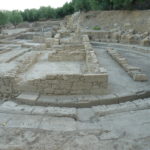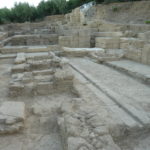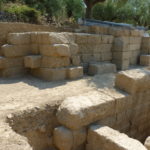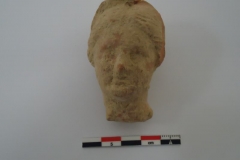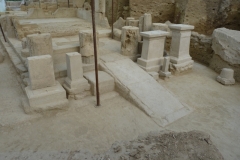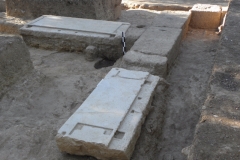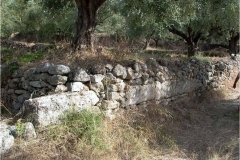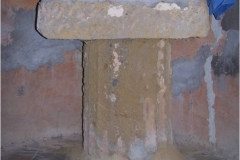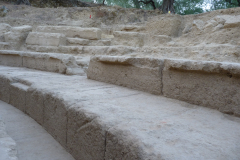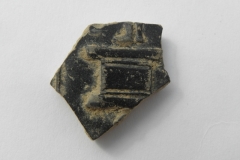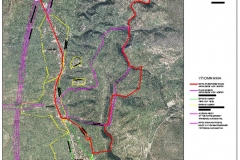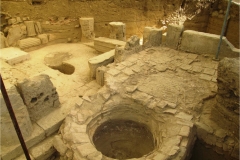In the year 2019 the systematic excavation of the ancient theater continued (Fig. 1).
The excavation focused on the skenotheke, the northern retaining wall and the area west of the skene. Inside the skenotheke three subsequent transverse walls came to light, made entirely of ancient members, and mainly of fallen stone blocks of the eastern wall of the skenotheke, in an almost isodomic, loose masonry with smaller intermediate stones and pieces of tiles (Fig. 2). The later walls define four uneven areas inside the skenotheke, which communicate with each other through doors 1,20m wide. At the eastern narrow end of one of the areas a large stone staircase was discovered consisting of six stairs, made entirely of ancient building material in second use (Fig. 3). The existence of the staircase as well as the thickness of the walls is an indication of the existence of a second floor in the later building.
The stone grooves of the mobile skene as well as the paved corridor between the second and third grooves were discovered along the floor of the skenotheke, below the later walls, that cross over them without destroying them. The maximum total revealed length of the grooves of the mobile skene to date (inside and outside the skenotheke) is 45m (Fig. 4).
The study of the northern retaining wall was completed, with the discovery of its northern end, after the removal of the massive stone blocks that come from the collapse of its upper part. The end of the northern retaining wall was reinforced with buttresses on its eastern and western sides, while its total length is estimated at about 16m and its maximum revealed height at 3,10m (Fig. 5).
HELLENICA MONASTERY-Church of Aghios Phanourios
To the west of the Hellenica Monastery of Thouria, in a natural cavity formed below the level of the current road, unknown part of the fortification wall of the ancient city was discovered at a depth of 1,20-1,60m from the surface of the ground. The wall, built isodomically, follows the formation of the ground with direction from north to south and at the southern end is bent with direction from east to west. The first part with direction from north to south is based on the natural rock and is preserved at a length of 5,50m and 3m height. The element with direction E-W lies beneath the modern small church of Aghios Phanourios and was discovered at a length of 11,50m and maximum preserved height of 3m, while it seems to continue to its western end (Fig. 6).
Dr. Xeni Arapogianni
February 2020

